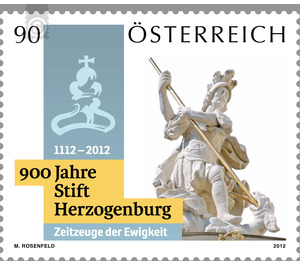900 years - Austria / II. Republic of Austria 2012 - 90 Euro Cent
Theme: Architecture
| Country | Austria / II. Republic of Austria |
| Issue Date | 2012 |
| Face Value | 90.00 |
| Edition Issued | 400,000 |
| Printing Type | offset |
| Stamp Type | Commemorative |
| Item Type | Stamp |
| Chronological Issue Number | 2328 |
| Chronological Chapter | OOS-OE2 |
| SID | 701465 |
| In 50 Wishlists | |
For half a year, from April 22 to October 28, 2012, the 900th anniversary of the Herzogenburg Abbey will be celebrated with numerous events and a newly designed art collection. Austrian Post accompanies the festivities with the publication of this special stamp. The attractive motif shows the statue of St. George, the patron saint, as well as the newly created jubilee logo. History: The imposing monastery - a convent of the Congregation of Austrian Augustinian Canons - was built in 1112 by Ulrich I of Passau in St. Georgen a. d. Traisen founded at the confluence of the Traisen with the Danube and relocated 1244 because of frequent flooding 10 kilometers upstream to Herzogenburg. This created the "Upper Market", which was administered by the Chorherrenstift manorial, while the "Lower Market" remained as a Bavarian foundation until his purchase in 1806 by the Chorherrenstift in the possession of the monastery Formbach. From 1714, the Herzogenburg Abbey was baroqueized by Jakob Prandtauer, Johann Bernhard Fischer von Erlach and Joseph Munggenast. The monastery was able to escape the Josephine suspension wave of the monasteries, the dissolved monasteries Dürnstein and St. Andrä on the Traisen were incorporated into Herzogenburg, so that the pen material significantly strengthened from the Josephine reforms emerged. The conversion of the monastery began with the laying of the cornerstone on 25 March 1714, the construction management had Jakob Prandtauer. With the commission of the stonemason works for the Emperor's Hall, a certain Johann Gallus Hügel entered the literature. In a letter he proved that Fischer von Erlach designed this hall. On April 22, 1716, he submitted a draft contract for the work on the new hall, on April 29, the contract was finally sealed. On the occasion of the 900th anniversary, with the support of the Province of Lower Austria and the city of Herzogenburg, a large-scale renovation of the monastery took place. Not only was the complete exterior façade and parts of the courtyard walls refurbished, but a revitalization program for the prelate garden, the orchard and the rose garden was successfully implemented. Inside, the renovations included the ballroom, the Frigdiani Chapel and the library. The valuable art collection, the treasury, the aforementioned monastery library with its ancient manuscripts and incunabula as well as the coin cabinet underline the art historical importance of the monastery in Austria. The motif of the stamp is the statue of the dragon killing St. George on the Georgitor in the south of the abbey grounds. However, the stamp shows them in mirror image, because St. George does not hold the right but the left arm upwards and, viewed from the viewer, does not stick to the right, but to the lower left. The stamp was not corrected.


